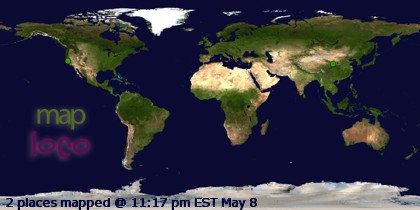 |
| A very similar view to what I saw out my window. |
Now, if I didn't know that "Above 29,000 feet (8,800 m) no aircraft shall come closer than 600 m (or 2,000 feet)", I would have shrugged off the ~500 foot separation. I know it wasn't 2,000 feet, since I could see nearly directly INTO the back of the 737-500's CFM56 engines, which would have been a very oblique view had the Southwest flight been 1/2 a mile or more above me.
I've been in my backyard swimming or working out when the landing pattern for Sky Harbor Airport has been from West-to-East, and had a plane's shadow pass over me as the commercial flight is slowing from about 250 to 170 mph as they decelerate to land, before banking to follow and parallel the I-10 to the airport. So it was not the first time a large flight's shadow as crossed my path. But it was the first time over 29,000 feet I had a shadow cross, and the 6th time I've been on a commercial flight that nearly collided with another plane (over New Mexico 2010, Siberia 2000, China 2001, Belgium 2001, Southern Indiana 2010) of which I am aware. I am quite certain there's been more aerial close calls, but like the pilot on CO369 a week ago, most of the time no evasive maneuver is made - Siberia 2000 was a near head-on at 7am as my Continental flight was heading due South and a Polar Express cargo flight was heading due north, in the same (but opposite) vectors, when the Continental 777 pilot made an extreme course correction that almost sent my just-served breakfast into the aisle and I watched the blue and white Polar cargo plane streak North at a relative speed of nearly Mach 2 about a 1000 feet to the West.of our starboard wing tip. Maybe the CO369's flight computer had no "collision avoidance" alarm. I don't know.
The most positive aspect of a potential in flight collision, is that the resulting cataclysmic fireball would probably instantly kill me, and make my wife a very rich widow. If the fireball didn't get me, and the impact threw me and my buckled-in seat clear, suffocation (above 15,000 feet) due to oxygen deprivation would knock me unconscious and I wouldn't notice the inevitable impact with the Earth below. And if the crash was below 15K altitude, and I didn't pass out, I'd have one heck of a rapid vertical fall (human terminal velocity is about 120 mph) for a minute or two.
As I laid on my yoga mat pool side this afternoon, admiring the beautiful blue sky with light wispy clouds soaring slowly above, the thought occurred to me "look up at the sky, not down at the ground, if you're ever thrown clear from the impact of a mid air collision". I try to look on the bright side. =)

I'm not sure the 200 foot minimum applies to *ertical* separation:
ReplyDeletehttp://en.wikipedia.org/wiki/Reduced_Vertical_Separation_Minima
2000 ft is the minima.. and the SW flight was alot closer than 2000, vertically. I didn't "hear" it or "feel" it passing, but I Saw it clearly.
ReplyDeleteOops. Lopped off a zero. It looks like they can go to 1000' vertical separation under certain circumstances. And if the airliners are going in intersecting directions, there's a chance that can go as low as 500'.
ReplyDelete